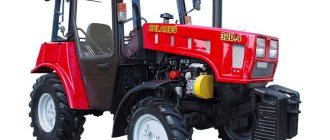The production of power plants UD15 and UD25 has been carried out for many years. During this period, they began to be used on various types of equipment. Thus, they were used to power the drive of an electrical unit, to transport power plants, MTZ-type walk-behind tractors and various road or construction equipment. The small engines themselves were created on the basis of the power plant from the Zaporozhets car, which was produced under the name MEMZ-966. The UD-15 engine itself is single-cylinder, while the UD-25 is already two-cylinder. However, both models are created using the same design, due to which the technical characteristics of the UD-25 engine, as well as the UD-15, are very similar. In addition, the units are unified in their design and most of their parts.
Total information
In 1967, the range of engines was expanded with units based on ZAZ-966 engines. One of the engines based on the Zaporozhets engine was the single-cylinder four-stroke UD-15. With a cylinder displacement of only 0.245 liters, the engine power is 6.5 horsepower at 3600 crankshaft revolutions. This power is achieved with the carburetor throttle fully open. In practice, the UD-15 engine operates under the control of a rev limiter and develops a long-term power of no more than 4 forces. The photo below shows a generator station with a single-cylinder engine.
The second engine of the new family was the larger two-cylinder UD-25. The engine, with a working volume of 0.490 liters, has a long-term power of about 8 horsepower. Structurally, the UD-25 engine is maximally unified with its single-cylinder counterpart. One of the features of the engines was the camshaft drive scheme, in which the gears are located directly inside the crankcase. The photo below shows a two-cylinder UD-25.
Both engines have a low compression ratio (6 and 7 units, respectively) and can run on gasoline with an octane rating of at least A72. According to the operating instructions for the UD 15 engine, the unit has the following overall dimensions and weight:
- length – 410 mm,
- width – 455 mm,
- height – 535 mm,
- weight – 41 kg.
Specifications
Download .xls file
xls
Download picture
Send by email
| OPTIONS | MEANING |
| Years of manufacture | 1967 - present d. |
| Cylinder block material | cast iron |
| Supply system | Direct injection |
| Type | in-line |
| Working volume, l | 0.42 |
| Power, l. With. | 12 |
| Number of cylinders | 2 |
| Number of valves per cylinder | 2 |
| Piston stroke, mm | 60 |
| Cylinder diameter, mm | 72 |
| Compression ratio | 6 |
| Speed rpm | 3000 |
| Fuel | gasoline A 72 |
| Fuel consumption, grams | 435(320) |
| Oil | in summer - diesel DP 11, DS 11, AC 10 |
| in winter – DP 8, AC 8 | |
| How much oil is in the engine, l | 3 |
| Engine weight, kg | 52 |
| Dimensions (length/width/height), mm | 530/455/565 |
The UD 25 engine is installed on road equipment, agricultural machines, and mobile power plants.
Bottom position - valve
The UD-1 and UD-2 engines have a lower valve arrangement, the UD-15 and UD-25 engines have an upper valve arrangement. The head and cylinder covers are ribbed to increase the cooling surface.
The interaction of the gas distribution mechanism parts with the lower valve arrangement is as follows. The engine camshaft is rotated by a drive from the crankshaft. When the camshaft cams run against the pushers, the latter rise and, overcoming the resistance of the valve springs, lift the valves. After the cams run down, the springs close the valves.
The cylinder head of engines with lower valves is simpler in design, since it contains only combustion chambers, water jackets, holes for installing spark plugs and attaching the head to the cylinder block. The channels for supplying the combustible mixture and exhaust gases are located in the cylinder block.
| Valve unit design. |
Mushroom-shaped pushers for a gas distribution mechanism with a lower valve arrangement have bolts with lock nuts that are screwed into the end from above and are designed to adjust the thermal clearance in the valves. Sometimes such pushers are equipped with a hydraulic device for automatically adjusting the thermal gap.
In addition, in engines with lower valves, the spark plugs are usually installed above the intake valves; if the spark plug protrudes into the chamber, the valve may touch it and break.
Then install the valves (for engines with lower valves) and the camshaft. The shaft gears are installed according to the marks on them.
To adjust these gaps in engines with lower valves (GAZ-52-01), the crankshaft is turned to a position in which the exhaust valve of the first cylinder is fully open. At the same time, the clearances in the intake valves of the first, third and fifth cylinders and in the exhaust valves of the second, third and sixth cylinders are checked and adjusted. The crankshaft is then set to a position where the exhaust valve of the sixth cylinder is fully open. Check and adjust the clearances of the intake valves of the second, fourth and sixth cylinders and the exhaust valves of the first, fourth and fifth cylinders.
The gas distribution mechanism of the GAZ-51A engine is of valve type, with a lower valve arrangement, located on the right side of the cylinder block and consists of camshafts, camshaft, pushers, valves, valve guides and pushers, valve springs with their fastening parts.
In modern automobile engines with high compression ratios and lower valves, the coefficient T ] V is small, since a decrease in the size of the combustion chamber causes a decrease in the flow area through which the mixture enters the cylinder. At average compression ratios, the flow section area is quite large, but with increasing compression ratio, this area decreases so much that it causes a significant decrease in the coefficient vv, and, consequently, a decrease in the average effective pressure.
| Cross section and diagram of the operation of a rotary piston engine. |
A comparison of the specific effective fuel consumption for the GAZ-51 engine with a bottom valve arrangement (curve 1 in Fig. 35) and the GAZ-51F engine with an overhead valve arrangement and flame ignition (curve 2) was carried out based on the load characteristics of these engines. From the given curves it follows that the use of torch ignition provides significant fuel savings, especially at low and medium loads.
| Diagrams of elevation, speed, etc. |
The lift, speed and acceleration of the valve for a gas distribution mechanism with a lower valve arrangement are determined by equations (353) - (356), since Lkl Lt and.
Adjustment of the thermal clearances between the ends of the valve stems and the pushers (with lower valves) or the toes of the rocker arms (with upper valves) is carried out using a set of flat feeler gauges.
Description
The UD 2 engine is a 4-stroke power unit with a bottom valve arrangement. The basic element of the engine is the crankcase, consisting of two body parts connected to each other. Inside it are installed parts of a crank mechanism that converts the reciprocating movement of the pistons into the rotational movement of a solid forged crankshaft.
The connecting elements between the pistons and the crankshaft are solid forged connecting rods, which have an I-beam cross-section. Each of them is connected to the corresponding piston by a special piston pin. The piston walls have grooves in which one oil scraper ring and two compression rings are installed.
Critical parts of the mechanism were made from:
- high-strength cast iron – cylinders, flywheel;
- aluminum alloy – pistons, cylinder heads.
A heavy flywheel mounted on the front extension of the shaft facilitates the removal of the connecting rod and piston group from the “dead spots” and, in addition, ensures the supply of cooling air to the cylinder head and directly to the cylinders. For this purpose, it is equipped with figured blades. The external drive coupling is installed on the rear side of the shaft.
The carburetor, fuel tank and air filter are mounted on the outer surfaces of the crankcase. Gasoline enters the carburetor by gravity from the tank, and the air filter cleans the air that enters the cylinders from dust. The crankshaft speed is controlled by a centrifugal governor, which controls the carburetor throttle valve.
Modifications
All stationary UD units are available in various versions, differing in attachments. The UD-15 engine, which was supplied to customers in the basic version and in the version with the index “G” for driving an electric generator, was no exception. The photo below shows this version of the motor.
The generator version of the engine was distinguished by an adapter bell mounted on the crankcase for mounting the generator and the presence of a ring gear on the flywheel. To start such a unit, an ST-351V electric starter with a voltage of 12 V was used. Another difference between the versions was the spark plugs. The UD-15 engine uses a spark plug model A10N or CH200, and the UD-15G generator motor uses a spark plug CH302-A.
Malfunctions
UD power units are characterized by a number of typical defects (see table).
| FAULT | CAUSE |
| Starting the engine is difficult or impossible. | Defects in the fuel supply system; The ignition system is faulty. |
| The engine does not develop the required power. | Ignition adjustment is broken; the jet is clogged; timing valve clearances are broken; The tightness of the gas pipeline is broken. |
| Extraneous knocking noise in the engine. | The ignition timing is incorrectly set; the presence of carbon deposits in the combustion chambers; the flywheel has become loose; parts of the connecting rod and piston group are worn out. |
| The engine gets very hot. | The ignition is not adjusted; the motor is overloaded. |
| Compression in the cylinders has decreased. | Wear of piston rings; timing valve clearances are broken; The cylinder head gasket was blown. |
Carter
The main part of the UD-15 engine is the aluminum crankcase with a tunnel design. It houses a separate front crankshaft bearing housing that is bolted on. In the front wall of the crankcase there is space for installing a gear pump and a pressure reducing valve for regulating the pressure in the lubrication system. On the outer side of the crankcase there is an axis for the foot pedal to start the engine.
The design of the engine crankcase provides a ventilation system through a special valve located near the magneto drive. The gases that break into the crankcase enter the rubber pipeline through the valve and then into the engine air filter.
Tuning
The UD 2 power unit, in the opinion of many owners, is quite capricious during operation. Therefore, it is quite often subjected to various modifications, which, by and large, can hardly be called tuning. However, they add stability and reliability to its work. The following modifications are most often carried out:
- reduce the volume of combustion chambers;
- rework the intake manifold;
- modify the lubrication system, making it full-flow;
- The magneto is modified by replacing the high-voltage coil with an ignition coil from a car.
Recommendations for repair of UD-15 and UD-25
To make the motor last longer, you should adhere to the following recommendations:
- Every month check the oil level and the condition of the filters.
- Every 100 hours of operation, clean the main elements from dirt and carbon deposits.
- Once every 200 hours worked, it is necessary to disassemble the engine compartment in order to check the tightness of the valves and other damage to the rings or cylinders.
- Every 500 hours of operation of the power plant, it is necessary to disassemble it, clean it, and change the oil.
The UD-15 and UD-25 engines are types of power plants created on the basis of the MEMZ-966 motor. These models are unified in their design. In many ways, their structure is identical and only a few elements differ.
For long-term operation and to avoid the need for repairs, it is recommended to regularly maintain and clean the motors.











